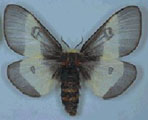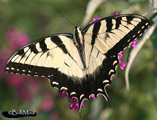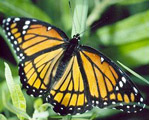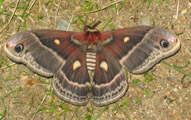Native Plants
Search for native plants by scientific name, common name or family. If you are not sure what you are looking for, try the Combination Search or our Recommended Species lists.
Prunus serotina
Prunus serotina Ehrh.
Black Cherry, Wild Black Cherry, Rum Cherry
Rosaceae (Rose Family)
Synonym(s):
USDA Symbol: PRSE2
USDA Native Status: L48 (N), CAN (N)
Ranging from southeastern Canada through the eastern United States west to eastern Texas, with disjunct populations in central Texas and mountains of the southwestern United States, Mexico, and Guatemala, Black cherry is a 25-110 ft. deciduous tree, distinctly conical in youth. When open-grown it becomes oval-headed with spreading, pendulous limbs and arching branches. Crowded trees grow tall and slender. Southwestern varieties are often shrubby. Leaves shiny on the upper surface; blade oblong with a long pointed tip and tapering base, margins finely serrate. White flowers are held in drooping racemes after the glossy leaves have emerged. The dark red fruit changes to black from August through October. Aromatic tree; crushed foliage and bark have distinctive cherry-like odor and bitter taste, owing to the same cyanide-forming toxic compounds, such as amygdalin, found in the wood and leaves of some other woody members of the Rosaceae. Fall foliage is yellow.
This widespread species is the largest and most important native cherry. The valuable wood is used particularly for furniture, paneling, professional and scientific instruments, handles, and toys. Wild cherry syrup, a cough medicine, is obtained from the bark, and jelly and wine are prepared from the fruit. While the fruit is edible and used in beverages and cooking, the rest of the plant contains amygdalin and can be toxic if consumed. One of the first New World trees introduced into English gardens, it was recorded as early as 1629 in Europe and is now highly invasive there and in northern South America. Five geographical varieties are currently distinguished: P. serotina var. serotina (Eastern black cherry) in eastern North America as far west as east Texas, P. serotina var. eximia (Escarpment black cherry) in central Texas, and varieties virens (Southwestern black cherry) and rufula (Chisos black cherry) in mountains of southwestern North America. Populations inhabiting the interior mountains of Mexico and Guatemala are assigned to the subspecies P. serotina ssp. capuli (Capulin black cherry) but are sometimes classed as variety salicifolia.
Plant Characteristics
Duration: PerennialHabit: Tree
Root Type: Fibrous
Leaf Retention: Deciduous
Leaf Arrangement: Alternate
Leaf Complexity: Simple
Leaf Shape: Oblanceolate , Ovate
Leaf Venation: Pinnate
Leaf Pubescence: Glabrous , Villose
Leaf Margin: Crenate , Serrate
Leaf Apex: Acuminate
Leaf Base: Cuneate
Leaf Texture: Smooth
Breeding System: Flowers Unisexual , Monoecious
Inflorescence: Raceme
Fruit Type: Drupe
Size Notes: Height depends on variety, with variety serotina reaching 110 ft. in the east, the Southwestern varieties less than a third that, and var. eximia maxing at ca. 50 ft.
Leaf: Green
Autumn Foliage: yes
Flower: Flowers 7-10 mm wide in 6-15 cm long racemes
Fruit: Black, Red 7-10 mm in diameter
Bloom Information
Bloom Color: WhiteBloom Time: Mar , Apr , May , Jun
Bloom Notes: Flowers right after leaves emerge.
Distribution
USA: AL , AR , AZ , CT , DC , DE , FL , GA , IA , IL , IN , KS , KY , LA , MA , MD , ME , MI , MN , MO , MS , NC , ND , NE , NH , NJ , NM , NY , OH , OK , PA , RI , SC , TN , TX , VA , VT , WI , WVCanada: NB , NS , ON , QC
Native Distribution: N.S. to MN & e. NE, s. to FL Panhandle & e. TX; disjunct populations in central TX and the southwestern US from west TX to AZ, south into mountains of Mexico and Guatemala.
Native Habitat: Moist or dry, open woods; fence rows; roadsides; old fields. Thickets, woodlands, canyons, floodplains, and lower riparian slopes.
Growing Conditions
Water Use: MediumLight Requirement: Sun , Part Shade , Shade
Soil Moisture: Dry , Moist
Soil pH: Alkaline (pH>7.2) , Acidic (pH<6.8) , Circumneutral (pH 6.8-7.2)
Cold Tolerant: yes
Soil Description: Well-drained soils. pH preference depends on variety and region, with Eastern Black Cherry preferring neutral to acidic, Escarpment Black Cherry rich but more calcareous limestone soils, and the Southwestern varieties accepting a broad range.
Conditions Comments: Black cherry is known for the beauty and quality of its wood. The green leaves turn to yellow in the fall. It is easy to grow and will reward you with dangling, lace-like blossoms in the spring. Its light and soil pH requirements vary by regional variety. Wildlife eat the fruits. This is a fast-growing, pioneer species. Eastern tent caterpillars prefer black cherries. The plant drops lots of twigs, leaves, and fruit, and in cultivation can be allelopathic to garden plants.
Benefit
Use Ornamental: A showy tree with handsome trunk and branches, attractive foliage, especially in fall, and ornamental blooms and fruit. Easy to grow.Use Wildlife: Fruit consumed by 33 species of birds and many mammals.
Use Food: Cherries eaten raw (must be pitted) and used in jellies, jams, pies, and as a flavoring extract in drinks and syrups.
Use Medicinal: Inner bark used in cough syrups, sedatives, and tonics.
Use Other: Wood long used in furniture making and other things because of its lustrous, dark red tint.
Warning: All parts of Prunus species except the fruits contain poisonous substances and should never be eaten. The bark, leaves, and seeds of this species are especially toxic. POISONOUS PARTS: Wilted leaves, twigs (stems), seeds. Highly toxic to humans and herbivorous mammals. May be fatal if ingested. Symptoms include gasping, weakness, excitement, pupil dilation, spasms, convulsions, coma, respiratory failure. Toxic Principle: Cyanogenic glycoside, amygdalin, prussic acid. (Poisonous Plants of N.C.)
Conspicuous Flowers: yes
Interesting Foliage: yes
Fragrant Foliage: yes
Attracts: Birds , Butterflies
Larval Host: Eastern Tiger Swallowtail, Cherry Gall Azure, Viceroy, Columbia Silkmoth, Promethea Moth, Small-eyed Sphinx Moth, Wild Cherry Sphinx Moth, Banded Tussock Moth, Band-edged Prominent, Spotted Apatelodes.
Nectar Source: yes
Value to Beneficial Insects
Special Value to Native BeesSpecial Value to Bumble Bees
Special Value to Honey Bees
Supports Conservation Biological Control
This information was provided by the Pollinator Program at The Xerces Society for Invertebrate Conservation.
Butterflies and Moths of North America (BAMONA)
|
New England buckmoth (Hemileuca lucina)  Adult Food Source |
Eastern Tiger Swallowtail (Papilio glaucus)  Larval Host |
Viceroy (Limenitis archippus)  Larval Host |
Columbia silkmoth (Hyalophora columbia)  Larval Host |
Propagation
Propagation Material: Hardwood Cuttings , Root Cuttings , Seeds , Semi-hardwood Cuttings , Softwood CuttingsDescription: Seeds require cold stratification, with variety eximia also needing after-ripening followed by warm stratification before cold stratification. Cuttings that work best are summer semi-hardwood.
Seed Collection: Collect fruit when it is filled out, firm, and its ripe color. Clean seeds from pulp and briefly air dry. (Seeds to be sown immediately in fall do not need drying.) Storage viability is maintained at 31-41 degrees.
Seed Treatment: For spring sowing, stratify seeds in moist sand for 30-60 days in a greenhouse, then cold stratify (36-41 degrees) for 60-90 days. Plant well before high temperatures.
Commercially Avail: yes
Maintenance: Keep fallen leaves, twigs, and branches picked up if you have herbivorous animals, as all parts except the fruit are highly toxic. Variety eximia may go drought-deciduous in summer, so water some during droughts to prevent this.
Find Seed or Plants
View propagation protocol from Native Plants Network.
Mr. Smarty Plants says
Edible Plants for North Georgia
January 10, 2010
We are planning a forest food garden in the hollers of the N GA Mountains.
Which edible fruit, nut, berry, herb and creepers would be best for this reddish, clay-like soil? The food garden is in...
view the full question and answer
Invasive, non-native Paulownia
May 03, 2006
Hi. We would like to plant a fast growing tree that will provide shade for our house. What do you think of the Paulownia tree (Empress Tree) as a possibility for the Austin area? If this is not a g...
view the full question and answer
National Wetland Indicator Status
| Region: | AGCP | AK | AW | CB | EMP | GP | HI | MW | NCNE | WMVE |
| Status: | FACU | FACU | FACU | FACU | FACU | FACU | FACU |
From the National Organizations Directory
According to the species list provided by Affiliate Organizations, this plant is on display at the following locations:Lady Bird Johnson Wildflower Center - Austin, TX
Pineywoods Native Plant Center - Nacogdoches, TX
Crosby Arboretum - Picayune, MS
Mt. Cuba Center - Hockessin, DE
Bibliography
Bibref 1255 - Bringing Nature Home: How You Can Sustain Wildlife with Native Plants (2009) Tallamy, Douglas W.Bibref 1186 - Field Guide to Moths of Eastern North America (2005) Covell, C.V., Jr.
Bibref 298 - Field Guide to Texas Trees (1999) Simpson, B.J.
Bibref 1185 - Field Guide to Western Butterflies (Peterson Field Guides) (1999) Opler, P.A. and A.B. Wright
Bibref 946 - Gardening with Prairie Plants: How to Create Beautiful Native Landscapes (2002) Wasowski, Sally
Bibref 481 - How to Grow Native Plants of Texas and the Southwest: Revised and Updated Edition (2001) Nokes, J.
Bibref 355 - Landscaping with Native Plants of Texas and the Southwest (1991) Miller, G. O.
Bibref 293 - Manual of the Vascular Plants of Texas (1979) Correll, D. S. & M. C. Johnston
Bibref 354 - Native & Naturalized Woody Plants of Austin & the Hill Country (1981) Lynch, D.
Bibref 663 - Poisonous Plants of North Carolina (1994) Vondracek, W. ; L. Van Asch
Bibref 281 - Shinners & Mahler's Illustrated Flora of North Central Texas (1999) Diggs, G. M.; B. L. Lipscomb; B. O'Kennon; W. F...
Bibref 291 - Texas Wildscapes: Gardening for Wildlife (1999) Damude, N. & K.C. Bender
Bibref 297 - Trees of Central Texas (1984) Vines, Robert A.
Bibref 1258 - Trees of Ontario (2007) Kershaw, Linda
Bibref 286 - Wildflowers of the Texas Hill Country (1989) Enquist, M.
Search More Titles in Bibliography
Additional resources
USDA: Find Prunus serotina in USDA PlantsFNA: Find Prunus serotina in the Flora of North America (if available)
Google: Search Google for Prunus serotina
Metadata
Record Modified: 2015-11-06Research By: TWC Staff, GDG